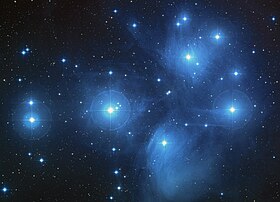Taygeta is a double star in the constellation of Taurus and a member of the Pleiades open star cluster (M45).
| Observation data Epoch J2000.0 Equinox J2000.0 | |
|---|---|
| Constellation | Taurus |
| Right ascension | 03h 45m 12.49578s[1] |
| Declination | 24° 28′ 02.2097″[1] |
| Apparent magnitude (V) | 4.30[2] |
| Characteristics | |
| Spectral type | B6IV + ?[3] |
| U−B color index | -0.48[4] |
| B−V color index | -0.12[4] |
| Astrometry | |
| Radial velocity (Rv) | 10.1[2] km/s |
| Proper motion ( | RA: 21.24 ± 0.38[1] mas/yr Dec.: -40.56 ± 0.35[1] mas/yr |
| Parallax ( | 7.97 ± 0.33 mas[1] |
| Distance | 440 ly (135 pc) |
| Details | |
| Taygeta | |
| Mass | 4.5[5] M☉ |
| Luminosity | 600[5] L☉ |
| 19 Tauri Ab | |
| Mass | 3.2[5] M☉ |
| Luminosity | 150[5] L☉ |
| Other designations | |
| Database references | |
| SIMBAD | data |
It consists of a binary pair designated 19 Tauri A together with a single star visual companion, 19 Tauri B. 'A's' two components are themselves designated 19 Tauri Aa (officially named Taygeta /teɪˈɪdʒətə/,[6] the traditional name for the entire system)[7] and Ab.
Based on parallax measurements obtained during the Hipparcos mission, 19 Tauri A is approximately 440 light-years from the Sun.
Nomenclature
edit19 Tauri is the system's Flamsteed designation. It also bears the little-used Bayer designation q Tauri. The designations of the two constituents as 19 Tauri A and B, and those of A's components - 19 Tauri Aa and Ab - derive from the convention used by the Washington Multiplicity Catalog (WMC) for multiple star systems, and adopted by the International Astronomical Union (IAU).[8]
The system bore the traditional name Taygeta (or Taygete).[9] Taygete was one of the Pleiades sisters in Greek mythology. In 2016, the I
Properties
editTaygeta presents as a blue-white B-type subgiant with an apparent magnitude of +4.30. It is a spectroscopic binary, whose component stars have magnitudes of +4.6 and +6.1. They are separated by 0.012 arcseconds and complete one orbit every 1313 days.
The 8th magnitude visual companion, 19 Tauri B, is 69 arcseconds away. It is thought to be a yellow star somewhat more massive and larger than the Sun, and further away than the Pleiades cluster.[11]
Taygeta was once reported to be variable,[12] but has since been measured to be one of the least variable of stars.[13][14]
References
edit- ^ a b c d e van Leeuwen, F. (2007). "Validation of the new Hipparcos reduction". Astronomy and Astrophysics. 474 (2): 653–664. arXiv:0708.1752. Bibcode:2007A&A...474..653V. doi:10.1051/0004-6361:20078357. S2CID 18759600. Vizier catalog entry
- ^ a b "* q Tau". SIMBAD. Centre de données astronomiques de Strasbourg. Retrieved 2014-08-18.
- ^ Eggleton, P. P.; Tokovinin, A. A. (September 2008), "A catalogue of multiplicity among bright stellar systems", Monthly Notices of the Royal Astronomical Society, 389 (2): 869–879, arXiv:0806.2878, Bibcode:2008MNRAS.389..869E, doi:10.1111/j.1365-2966.2008.13596.x, S2CID 14878976.
- ^ a b Penston M.J. (1973). "Photoelectric UBV observations made on the Palomar 20-inch telescope". Mon. Not. R. Astron. Soc. 164 (2): 133–154. Bibcode:1973MNRAS.164..133P. doi:10.1093/mnras/164.2.133.
- ^ a b c d Professor James B. (Jim) Kaler. "TAYGETA (19 Tauri)". University of Illinois. Retrieved 2014-08-18.
- ^ Davis, George A. (1944). "The pronunciations, derivations, and meanings of a selected list of star names". Popular Astronomy. 52: 8–30. Bibcode:1944PA.....52....8D.
- ^ a b "Naming Stars". IAU.org. Retrieved 5 March 2018.
- ^ Hessman, F. V.; Dhillon, V. S.; Winget, D. E.; Schreiber, M. R.; Horne, K.; Marsh, T. R.; Guenther, E.; Schwope, A.; Heber, U. (2010). "On the naming convention used for multiple star systems and extrasolar planets". arXiv:1012.0707 [astro-ph.SR].
- ^ Allen, Richard Hinckley (1899). Star-names and their meanings. G. E. Stechert. p. 407. Retrieved 2009-10-10.
- ^ IAU Working Group on Star Names (WGSN), International Astronomical Union, retrieved 22 May 2016.
- ^ Huber, Daniel; Bryson, Stephen T; Haas, Michael R; Barclay, Thomas; Barentsen, Geert; Howell, Steve B; Sharma, Sanjib; Stello, Dennis; Thompson, Susan E (2016). "The K2 Ecliptic Plane Input Catalog (EPIC) and Stellar Classifications of 138,600 Targets in Campaigns 1-8". The Astrophysical Journal Supplement Series. 224 (1): 2. arXiv:1512.02643. Bibcode:2016ApJS..224....2H. doi:10.3847/0067-0049/224/1/2. S2CID 118621218.
- ^ Samus, N. N.; Durlevich, O. V.; et al. (2009). "VizieR Online Data Catalog: General Catalogue of Variable Stars (Samus+ 2007-2013)". VizieR On-line Data Catalog: B/GCVS. Originally Published in: 2009yCat....102025S. 1. Bibcode:2009yCat....102025S.
- ^ Percy, John R.; Wilson, Joseph B. (2000). "Another Search for Maia Variable Stars". The Publications of the Astronomical Society of the Pacific. 112 (772): 846. Bibcode:2000PASP..112..846P. doi:10.1086/316577.
- ^ Adelman, S. J. (2001). "Research Note Hipparcos photometry: The least variable stars". Astronomy and Astrophysics. 367: 297–298. Bibcode:2001A&A...367..297A. doi:10.1051/0004-6361:20000567.
